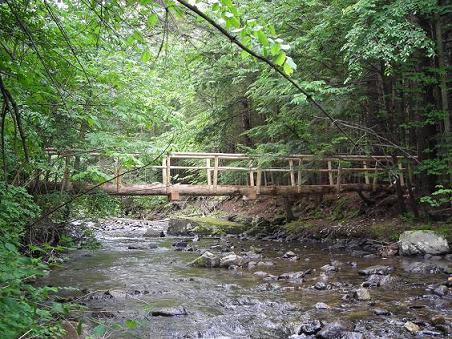
Finals week has finally arrived. Seeking escape from the drudgery, I looked for yet another Hanover trail to hike. Not having much time, I settled on Mink Brook, a riverside trail about ten minutes from the Green. With another member of The Review—one of the few who possesses a car and the good sense to be sober at 2pm on a Sunday—I set out hoping to find a moment of peace amid the turmoil of Week Ten. And for ten minutes or so, I found it. The placid river to the right distracts from the odd house or two to the left, and the level trail allows for an easy “hike” while also technically counting as leg day. Yet, all too soon my ignorant bliss was shattered by a cruel imposition of the worst excesses of today’s world. Those who have walked the trail before will know that it is semi-famous for an unusual bridge that spans its namesake brook. It consists of a narrow log supported by metal cables and guarded by wooden rails on each side. While unconventional, it is perfectly safe, certainly safer than the unsupported planks above wide chasms that make up many of the trail’s other bridges. Yet, upon coming into sight of the bridge we saw a curious obstruction in our way. A crude piece of plywood had been nailed across the entrance to the bridge, and a sign reading “closed for safety” had been attached to it. We were confused as to what the problem was, as the bridge itself looked perfectly undamaged except for wooden cross beams screwed into one’s path to prevent use of the bridge. However, never wanting to question the wisdom of Hanover’s bureaucratic brain trust, we instead clambered over slippery rocks a hundred or so feet upstream, clearly a safer option than crossing a bridge. Once across, we made our way to the other side of the bridge to find further clues as to its closure. We saw yet another plywood board nailed across, but, in addition to the safety sign, we found another sign. This one came with a QR code and a paragraph in sixteen-point Arial font. To paraphrase, it read that the bridge had been closed “out of concern for hikers” and that a committee of students and administrators would design a new bridge that is “more reflective of our community.” It took us a minute to even begin to understand the meaning of the offending sign. How could a bridge possibly reflect our community? Is there a substantial portion of hikers who have a phobia of suspension bridges? Still confused, I took the poster for further investigation and made a mental note to fill out the informational survey that the QR code advertised. We walked on for 20 or so minutes, only getting lost once and seeing the most beautiful power lines that Hanover’s forests have to offer. Upon returning to the bridge, we came to the decision that if the goal was safety, crossing a bridge certainly could not be less safe than doing our best not to slip and fall crossing wet rocks, and so we blambered over the plywood board and wooden cross pieces, making it to the other side with only a few splinters. I must confess that at the time I thought the government-sanctioned vandalism of the bridge was simply a moronic attempt to satisfy the complaints of some retired HR coordinator whose inbred Walloonian demi-poodle named Cynthia will not cross running water until the bridge is at least 25 handwiths above the riverbank. Yet, I now realize that it is in fact an artistic statement, a perfect encapsulation of the Hanover community. Destroying a perfectly usable and interesting bridge, refusing to install a replacement and instead forcing hikers to wade through a fast-moving stream, doing nothing whatsoever to repair the rotting plank-bridges that span twenty-foot chasms farther along the trail, and slapping a QR code with a Google survey about artistic bridge preferences is just the kind of performative self-aggrandizing faux-liberalism that the Hanover community is known for. Truly, I applaud whatever 21st-century Warhol came up with a masterpiece that so completely expresses the values of our special little bubble.

James, thank you for this most entertaining account of your reaction to the Confounding Dilemma of the Rotten Mink Brook Log Crossing. ‘Twas the Hanover Conservancy, that small but spunky local land trust (oldest in NH, founded by Dartmouth folk) that closed the crossing last year – pieces of it were literally falling off and people were enjoying the Indiana Jones rush of bouncing on the alarmingly funky log a little too much. We’re sorry to disappoint you that the government was not to blame.
After failing to find a big enough tree for a new span (Tropical Storm Irene widened the channel, creating a need for a longer one than we had), we were relieved when a crack team of Thayer engineering students stepped up last fall to develop an intriguing new design, this time for a rustic suspension bridge. They finished their work a month or so ago, and we’re in the final stages of securing the approvals we need to replace the rotten log with something safe but still pretty cool, that meets the restrictions in our conservation deed (again, no government there either). Your account of crossing the rotten log and walking up the streambank is a helpful anecdote as we make our case to secure those permissions. We’ll be sure to let you know when we’re ready to build – and hope you and your buddy might join the volunteer construction crew. And glad you enjoyed our Mink Brook Nature Preserve!
Thank you for answering my question WHY is the bridge off limits? Very concise explaining of what is safe and what isn’t.